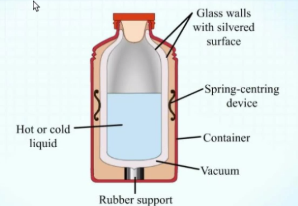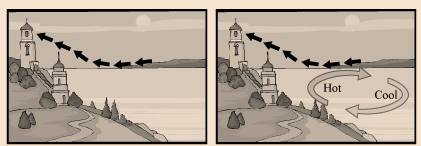Heat
Based on Maharashtra Board General Science Chapter 9-Audio Notes, Solution, Video, PDF, Test
Notes
[responsivevoice voice="UK English Female" rate="0.8" pitch="0.8" buttontext="Listen to this"]
Q. Rub your palms against each other and put them on your cheeks. What do you feel?
Ans. Heat is produced due to friction.
Heat : Heat is a form of energy. It can flow from one place to another which is called transfer of heat.
Heat is transferred by modes called conduction, convection and radiation.
Conduction : Transfer of heat from a hot part of a solid substance to its cold part is Called conduction. For conduction of heat a medium is required. It means heat cannot be conducted in vacuum. Conduction of heat takes place in solid substances.
Good and bad conductors of heat :
- Substances which easily transfer heat are called good conductors of Examples: copper, gold, aluminum etc.
- Substances which do not transfer heat are called bad conductors of heat. Examples: wood, plastic, paper, glass.
Q. Why does the halwai wrap up cloth around the end of his slotted spoon while stirring the boiling milk in his large kadhai?
Ans. When the slotted spoon comes in contact with the boiling milk, heat is transferred to the spoon because metal is good conductor of heat. The halwai may get a burn if he touches the hot spoon. To avoid burning of hand by holding the spoon while stirring, he wraps up a cloth around the end of the spoon. The cloth being a bad conductor of heat, does not transfer the heat to the hands of halwai. Hence, the halwai wraps up cloth around the end of his slotted spoon while stirring the boiling milk.
Q. Why do we hold a steel glass in a handkerchief while drinking hot milk from it? What are other examples of this kind? Make a note of them.
Ans. The handkerchief being a bad conductor of heat, does not transfer the heat to our hands from the steel glass. Therefore we hold a steel glass of hot milk in a handkerchief.
Some other examples are:
Cooking utensils are made with plastic coated handles.
We wear hand gloves while taking out hot pot from an oven.
Convection: In liquids, heat is transferred by means of convection. When heat is supplied at the bottom of a container, water at the bottom warms up first. As warm water has lower density it moves upwards and it is replaced by the surrounding cold water.
Owing to difference in density currents are formed and heat is transferred. Such transfer of heat by means of currents is called convection.
Convection of heat also requires a medium which may be in liquid or gaseous form. In liquids and gases heat is transferred by convection.
Q. Why do we use white clothes in summer and dark or black clothes in winter?
Ans. Absorption and reflection of heat radiations depends on the colour of the object.
White and light colours reflect most of the heat falling on them and dark or black colours absorb most of the heat.
Hence, to help in maintaining our normal body temperature we use white clothes in summer and dark clothes in winter.
Q. Why do we wear woollen clothes in winter?
Ans. Wool is a bad conductor of heat. The woollen clothes prevent the flow of heat from our body to the surroundings. Hence, we wear woollen clothes to keep our body warm during winter.
Radiation : Transfer of heat by means of electromagnetic waves is called radiation.
- It does not require solid or liquid medium.
- In space and vacuum heat is transferred by radiation.
- Radiation may occur even in the presence of solid or liquid medium. When heat waves fall on an object a part of it is absorbed and the rest is reflected.
Remember :
- Metals expand when heated and contract when heat is taken away.
- Generally, liquids expand when heated and contract when cold.
- Heat causes gases to expand and their volume reduces when heat is taken away.
All solids, liquids and gases expand on heating and contract on cooling.
Q. Why is there a gap at the joints of rails and of cement concrete bridges?
Ans. All solids, liquids and gases expand on heating and contract on cooling.
Rails made from metals and bridges contain some metals which may expand during summer due to temperature rise.
If there is no gap provided at the joints of these metals, the expansion may destroy the bridge or rail structure or may cause serious accidents.
Hence, to provide room for expansion of solids, there is a gap at the joints of rails and cement concrete bridges.
Q. Why is mercury or alcohol used in thermometer?
Ans. Mercury is a good conductor of heat, Mercury and alcohol need very little heat to expand. As a result, they can measure slight changes in temperature easily. Hence, mercury or alcohol is used in a thermometer.
[/responsivevoice]
[responsivevoice voice="UK English Female" rate="0.8" pitch="0.8" buttontext="Listen to this"]
In thermos flask hot substances remain hot and cold substances remains cold for long time.
Thermos Flask (Dewar flask):
Scottish scientist Sir James Dewar made first thermos flask in 1892. Hence, it is also known as the Dewar flask.
- Thermos flask is used to maintain the temperature of the hot or cold substances kept inside it
- In this flask glass tube is used to avoid the heat transfer from the inside of the flask to the surroundings.
- It is a double-walled flask which has two glass tubes, one placed inside the other. The inner walls of the glass-tubes of the flask are silver coated and shiny. Hence, the heat radiations are reflected and trapped inside the flask, thus, avoiding heat transfer by radiation.
- Vacuum created between inner and outer glass tubes, avoid heat transfer by conduction and convection.
- The tubes are covered with a protective jar of metal or plastic. The flask is protected by the pieces of sponge or rubber fixed between the outer jar and the flask.
- In this manner, the temperature inside the flask is maintained. However, a little heat is lost from around the lid and by conduction through the glass. [/responsivevoice]

Solution
Question 1:
Fill in the blanks with the proper word from the brackets.
(radiation, white, conduction, blue, convection, bad conductor, good conductor, black, reflection)
(a) Maximum heat is absorbed by a ................ coloured object.
(b) ...................... of heat does not require a medium.
(c) Conduction of heat takes place through a .......................... substance.
(d) The shining surface in a thermos flask decreases the outgoing heat by ......................... .
(e) Cooking utensils are made from metals due to their property of ................. .
(f) The earth receives heat from the sun by .................... .
(a) Maximum heat is absorbed by a black coloured object. (b) Radiation of heat does not require a medium. (c) Conduction of heat takes place through a good conductor substance. (d) The shining surface in a thermos flask decreases the outgoing heat by reflection. (e) Cooking utensils are made from metals due to their property of conduction. (f) The earth receives heat from the sun by radiation.
Question 2:
What will absorb heat?
-Steel spoon, wooden board, glass vessel, iron griddle (tava) , glass, wooden spoon , plastic plate, soil, water, wax.
Steel spoon, iron griddle (tava), water and wax are the good conductors of heat. Hence, these substances would absorb heat. Wooden board, glass vessel, glass, wooden spoon, plastic plate and soil are bad conductors. Hence, they would absorb very small amount of heat that can be neglected.
Question 3:
Write answers to the following question. Heat is transferred from a hot body to a cold body.
(a) How does a fever get lowered by putting a cold compress on the forehead of a patient ?
(b) Why are the houses in Rajasthan painted white ? Climate of Rajasthan city is very hot and has houses with their walls painted white. Because of white colours are reflectors of heat, most of heat from the Sun is reflected back to the atmosphere. This keeps the houses cool from inside.
(c) What are the modes of heat transfer ? There are three modes of heat transfer:
(d) Explain which mode of heat transfer causes sea breezes and land breezes.
Similarly, during night time air above the land is cooler than air above the sea. The air above the sea being hotter moves upwards and is replaced by comparatively cooler air moving from the land forming convection currents. In this way, land breeze is set up. Convection causes sea breeze and land breeze. Heat transfer through fluids takes place by the process of convection.


(e) Why is the outer coat of the penguins of Antarctica black ?
Black colour is good absorbers of heat. In cold regions like Antarctica, the black outer coating of Penguins helps them to absorb as much heat from the surrounding and keep their bodies warm.
(f) Why are heaters fitted near the floor and air conditioners, near the ceiling of a room ?
Room heaters are fitted near the floor because this allows the hot air near the heater to rise up and warm the entire room.
The air conditioners are fitted near the ceiling, so that the cold air from the AC takes the place of hot air rising up from the bottom. In this way, the entire room gets cooled.
Question 4:
Give scientific reasons.
(a) An ordinary glass bottle cracks when boiling water is poured into it, but a borosil glass bottle does not.
When boiling water is poured into a glass bottle, the glass surface that comes into the contact with hot water heats up and expands.
(b) The telephone wires which sag in summer become straight in winter.
All substances expand on heating and contract on cooling Due to this low temperature, the metallic telephone wires are cooled down and thus contracts in length. Due to this, they become straight.
(c) Dew drops form on the grass in winter.
In winters, the temperature of the air near the grass decreases to dew point. Thus, the air becomes saturated with water vapour. As a result, water vapour condenses into tiny water droplets which appears on the surface of the grass.
(d) In winter, why does an iron pillar feel colder than a wooden pole ?
Videos
Click on below link to open video
1- Full Chapter
Click on below link to Download PDF
Class 7-General Science-Chapter-9-Heat-Notes
| Main Page : Class 7th MSBSHSE – General Science - All chapters notes, solutions, videos, test, pdf.
Books : Maharashtra Board-Class 7 Science Text Books – Chapter wise PDF for download Previous Chapter : Chapter 8 : Static Electricity - Online notes Next Chapter : Chapter 10 : Disaster Management - Online notes |
This is very helpful to me my brother ask me this type of question
I appreciate your work brooda… 😊